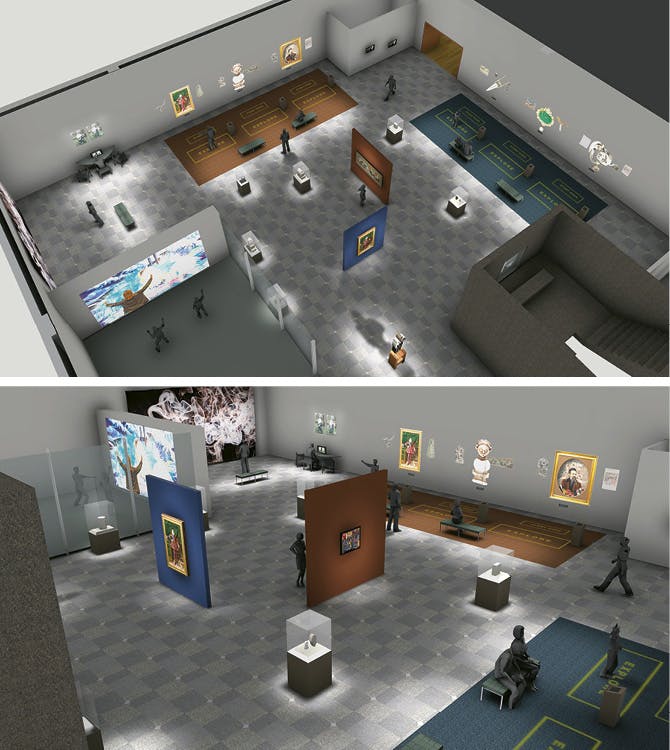
- Magazine Article
- Building and Grounds
- Digital Innovation
ArtLens Gallery
Gallery One’s equally innovative successor opens in June

Renderings Computer-generated views of the new ArtLens Gallery (James Engelmann)
The Cleveland Museum of Art’s Gallery One, an ambitious project that shone the international spotlight on the CMA, has been used as a case study in multiple publications and as a prototype for museums worldwide. Over the past four years we’ve gathered information by interviewing visitors, tracking usage, and evaluating the effectiveness of each gallery component, a process that has helped us understand exactly how digital interactivity can be used to engage and to educate. This information underpins ArtLens Gallery, the next iteration of our interactive, intergenerational learning space that melds art and the latest technology in compelling and innovative ways to enrich and inform the museum experience.
Three years ago the museum introduced ArtLens, the ingenious smartphone application that brought Gallery One’s integration of art and technology to a handheld device, using responsive navigation to help visitors find and learn about works of art throughout the museum galleries. The concept proved so compelling as a metaphor for exploration and discovery that the museum is now integrating all of its technological and interactive initiatives under the ArtLens name. The new ArtLens Gallery comprises ArtLens Studio (formerly Studio Play), ArtLens Exhibition (the central area featuring real works of art from the collection), ArtLens Wall (formerly the Collection Wall), and ArtLens App.

The ArtLens Exhibition space, closed for renovation this spring, reopens in June with a new configuration that eliminates competition for visitors’ attention between the digital and the physical by intertwining the experiences. Rather than positioning touchscreens in front of the artworks, ArtLens Exhibition will reverse the digital experience with the artworks positioned prominently in the foreground. These 20 works of art, representing artistic production from around the world, mirror the diversity of the museum’s collection and include familiar works such as Frans Pourbus’s Portrait of King Louis XIII of France, Stephan Balkenhol’s Standing Man, and Edgar Degas’s Frieze of Dancers juxtaposed with large-scale contemporary works like Pae White’s monumental tapestry Smoke and Frank Stella’s large aluminum sculpture that seems to hover as if weightless.

The new interactive games in this space augment visual literacy skills by teaching visitors about composition, gesture, expression, purpose, and symbols, thus inspiring them to look at works again with a new understanding. Transitioning away from the touchscreen technology of Gallery One, these interactives respond seamlessly to body movement as the visitor approaches artworks, immersing the user in the experience. This is not technology for technology’s sake, but rather keeps the focus of the visitor on the artwork—a thoughtful approach that makes the technology uniquely unobtrusive and strengthens the connection between visitors and the art in the process. Visitors first approach and engage with the art object, then activate the projections in the background. By participating in a variety of games in each ArtLens Exhibition interactive, developed with input from a cross-collaborative museum team, visitors engage and have fun while gaining important skills to strengthen their understanding of the art. Armed with these new tools and information, and infused with increased enthusiasm and confidence, visitors can personalize their connection to the museum’s collection.

One of the 16 new games in ArtLens Exhibition uses eye tracking to reveal a visitor’s areas of focus on an artwork. Visitors can see whether they tend to identify distinct geometric compositions within a painting, examine foreground over background, or focus on certain details over others. The visitor can create an eye-tracking map over the artwork that will be compared to the artistic intention, as well as the results of other visitors. This is just one of the innovative ways the museum is testing and implementing new technology to encourage visitors to look closer at artworks and gain a deeper understanding of how they interact with art
Each component of ArtLens Gallery serves as a launching point for visitors, whether casual attendees, intergenerational families, or lifelong art lovers, to engage with art and connect with the collection in a new and dynamic way. We look forward to debuting this new iteration of Gallery One as ArtLens Gallery, and to unveiling ArtLens Exhibition on Solstice weekend this June.
